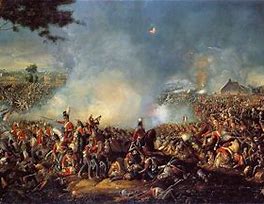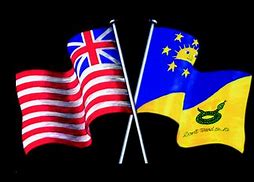With so many recent contemplations of potential alternate histories if various events had turned out differently, here are a few older examples from that burgeoning subgenre.
 WHAT IF NAPOLEON HAD WON AT WATERLOO? (June 18th 1815) – In 1907 G.M. Trevelyan penned an essay on this topic. In Trevelyan’s take, Napoleon had been chastened by his temporary exile to Elba before escaping and regaining control of France.
WHAT IF NAPOLEON HAD WON AT WATERLOO? (June 18th 1815) – In 1907 G.M. Trevelyan penned an essay on this topic. In Trevelyan’s take, Napoleon had been chastened by his temporary exile to Elba before escaping and regaining control of France.
Bonaparte’s health was failing badly. In fact, his erratic behavior during his ill-considered invasion of Russia has been attributed to a possible stroke in some theories. Feeling limited in his ability to once again lead armies of conquest to rebuild his continent-spanning empire, Napoleon decided to master diplomacy the way he had previously mastered warfare.
Dealing from his position of strength following his victory at Waterloo in this alternate timeline, the Emperor was astonishingly lenient in dealing with his defeated enemies. He imposed no harsh conditions on their surrender and ultimately emerged with his empire extending to the Rhine and with French hegemony of the Italian Peninsula recognized.
(There was not yet one unified nation called Italy. The peninsula was made up of multiple smaller states.)
Economic conditions in postwar France were not conducive to Napoleon going back on his word even if he had wanted to. Though retaining a certain popularity the French citizens made it clear they were weary of war, so Bonaparte contented himself with the mental chess game of statesmanship while always keeping a large standing army for purely “defensive” purposes.
England, on the other hand, saw its economy collapse. This was brought on by the financial strain of maintaining a large army and navy as well as lending financial assistance to its allied nations in this wary Cold War with the French Empire.
The citizenry became resentful and unruly, but the government showed no restraint in using its necessarily large armed forces against everything from incipient uprisings to mere public demonstrations. As many Brits faced starvation during the 1820s, Lord Byron led a working class revolt against HMG in 1825.
Apparently destined to be ill-fated in war no matter the timeline, Byron’s failures of command led to the swift suppression of this revolt and he was executed after his defeat. Byron became viewed as a martyr and inspired the likes of Percy Shelley to turn to writings of a revolutionary nature.
Shelley and others formed a radical university at Manchester which preached class equality as well as sweeping educational & economic reforms. Meanwhile, the lands of South America had risen in rebellion against their former colonial masters as happened in our timeline, too.
England and Spain faced even further strain, but combined to send substantial forces to try putting down the South American uprisings.
Trevelyan’s essay ended with Napoleon’s death from natural causes as the South American continent became ravaged by an apocalyptic war between colonialist forces and would-be republics.
 WHAT IF THE BRITISH HAD WON AT SARATOGA? (October 17th, 1777) – For Want of a Nail, a 1973 novel by Robert Sobel, examined the possible changes to history if Burgoyne had defeated Gates’ American Army at the Battle of Saratoga.
WHAT IF THE BRITISH HAD WON AT SARATOGA? (October 17th, 1777) – For Want of a Nail, a 1973 novel by Robert Sobel, examined the possible changes to history if Burgoyne had defeated Gates’ American Army at the Battle of Saratoga.
In this alternate sequence of events, after Burgoyne’s victory at Saratoga, the ever-moody George Washington stepped down as the overall commander of the American rebel forces. By June 1778 the last of the rebels surrendered.
The advisors of the crazed King George III had him grant a general amnesty but revolutionary leaders like John Adams, Patrick Henry, Thomas Jefferson and Thomas Paine were put to death. George Washington himself received life in prison.
To streamline their colonial administration of America the British split the region into three separate Confederations – Northern, Central and Southern. Scattered resistance to British rule flared up from time to time and from place to place.
James Madison and James Monroe led thousands of like-minded seekers of freedom to what is now Texas and vicinity. Once there they established a nation they named Jefferson and thrived for decades.
Come 1816 the Jeffersonians allied themselves with revolutionary forces in the decade-old Mexican Civil War. Under the Jeffersonian General Andrew Jackson all of Mexico was made part of Jefferson and the new geo-political entity was called the United States of Mexico.
In 1835 a financial depression in England caused a panic in the three American confederations. By 1839 conditions in the Northern Confederation were so severe that assorted Native American tribes set aside their differences to strike at the colonists.
The Indian uprising was defeated before year’s end but 1840 saw widespread strikes and mob rioting. Daniel Webster, the Colonial Governor of the Confederation of North America, was assassinated, causing the suspension of civil liberties as the army was used to brutally squelch the unrest.
Meanwhile, the Southern Confederation went through convulsive changes. By 1839 slavery was deemed no longer economically feasible and in 1840 it was abolished. However, Democrat hardliners had insisted on emancipation clauses which they exploited to prolong slavery by two more generations.
Gold was discovered in California in 1838 and in 1845 silver was discovered in a western region claimed by both the Confederation of North America and the United States of Mexico. The six-year Rocky Mountain War broke out over the dispute.
In 1851 the USM President Pedro Hermion was assassinated and the demoralized nation sued for peace. The USM retained California and some adjacent territory but the CNA was the big winner and was one of the world’s major industrial powers by the end of the war.
Over the next 14 years the CNA experienced massive success and a population explosion from the arrival of British immigrants. In 1865 a California mining magnate named Bernard Kramer formed Kramer Associates and began constructing a canal across Guatemala to increase global trade with the United States of Mexico.
The 1860s and 1870s were a boom time for the Confederation of North America, complicated only by criminal gangs seizing increasing economic and political influence. The Bloody Eighties brought a worldwide financial panic which led to violent rebellions all across Europe and in the United States of Mexico.
The CNA survived, thanks to its enormous wealth, but the USM became a dictatorship under Benito Hermion, called El Jefe. Under Hermion several wars of conquest were waged, beginning with the Isthmian War of 1886. By 1896 El Jefe had conquered or forced alliances upon all the nations of South America.
Meanwhile, Kramer Associates continued to thrive and had projects on every continent. In 1892 Kramer Associates played a major role in making the islands of Hawaii a dependency of the Mexican Dictatorship. The Great Northern War, called “a splendid little war”, was fought in 1893 and saw Mexico seize all of Alaska from Tsarist Russia.
In 1909 war broke out between France and the Mexican Dictatorship, with Mexico defeating the French in just one hundred days. The dictatorship was the only nation in the world which still allowed slavery and assorted Mexican slaves had sided with doomed France during the war.
Trials for those slaves dragged on into 1914, when riots broke out, egged on by support from CNA organizations dedicated to the elimination of slavery. Hundreds died, and the riots nearly caused war to break out between the Mexican Dictatorship and the CNA. In 1920 Mexico finally ended slavery.
Kramer Associates announced it would move its headquarters from California to the Philippines, the fallout of which caused a global depression. The CNA was left financially crippled and in 1939 a rebellion in the Ottoman Empire snowballed into a World War.
Mexico and the German Empire fought the empires of Britain, France and Japan. The CNA was so weakened that they stayed out of the conflict and remained neutral. The World War ended in 1948, with the French and British Empires now viewed as lesser powers compared to the CNA, Mexico and the German Empire.
The one true victor of the war, however, was the international conglomerate Kramer Associates which had become a virtual global confederation by making money off both sides during the conflict. Mexico and the CNA lapsed into a Cold War with each other.
In 1962 Kramer Associates exploded the world’s first atomic bomb, leading to a worldwide scramble for other powers to steal and/or develop nuclear arms of their own to try escaping the hegemony of Kramer Associates.
The novel ends in 1971 with the CNA and Mexico possessed of the world’s largest nuclear arsenals. The rest of the globe watched their Cold War warily, fearing what might become of the world if a nuclear war broke out between those two dominant superpowers.

Both intriguing alternatives!!!
I agree! If this post proves popular I will review several more of these.
I shall keep my fingers’ crossed!! 🙂
Thanks!
I liked these. Food for thought about how things might have gone.
Thanks! I agree!
How about What if Joe Biden was competent and not a crook?
That’s too far-fetched.
Joe Biden is the worst! We Casnaws are all in for Trump. I really admire the man!